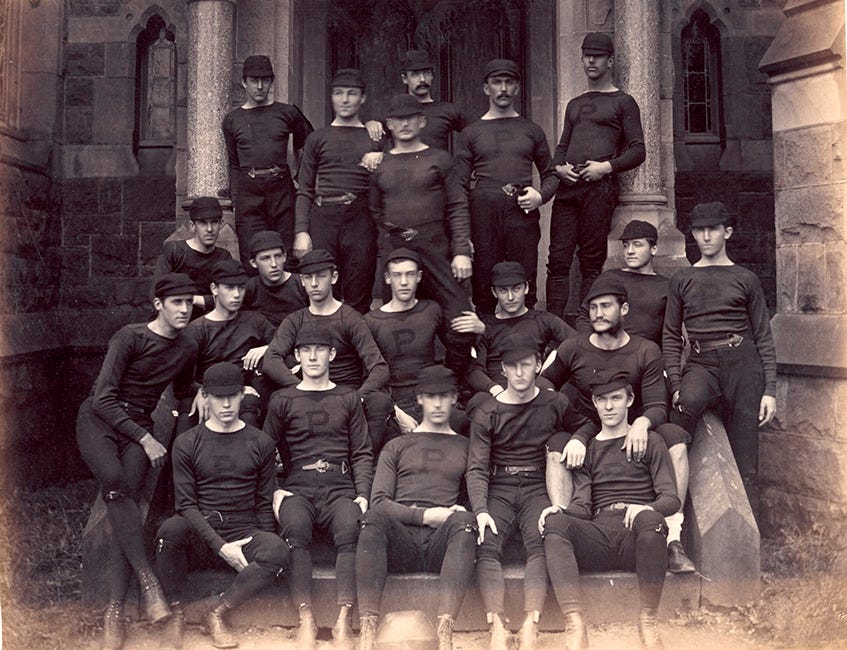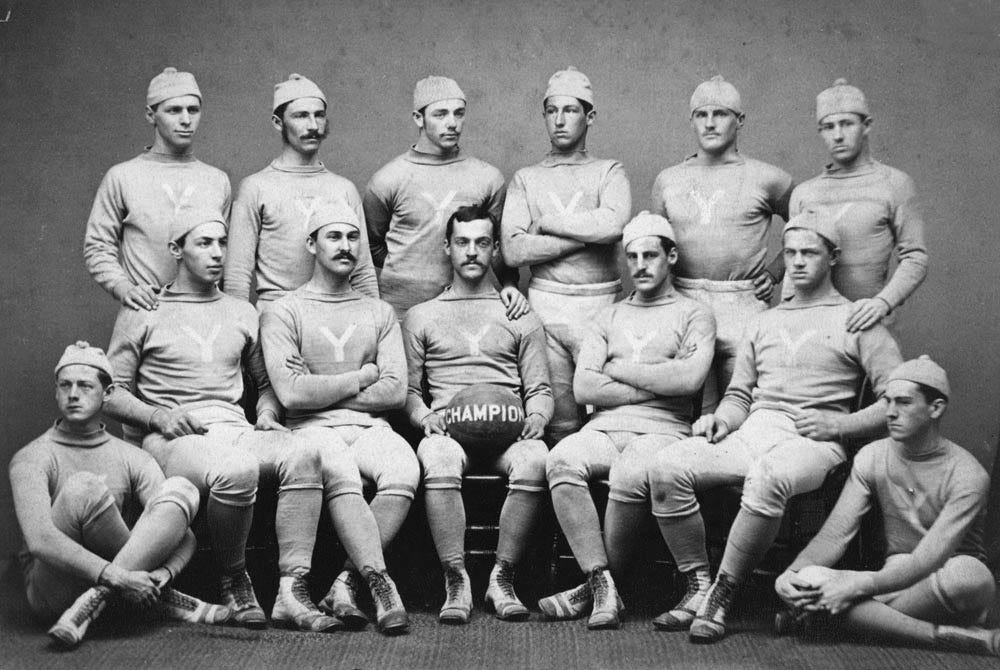Celebrating 145 Years of Thanksgiving Day Football
Gridiron football emerged from a primordial ooze of soccer and rugby. The Rutgers-Princeton game of 1869, considered the first college football game, had twenty-five players per side and used a round ball and soccer-like rules. Other schools began playing rugby, and the inconsistency led Yale, Harvard, Princeton, and Columbia to form the Intercollegiate Football Association on Thursday, November 23, 1876. They adopted a slightly tweaked version of rugby as their common game, with the first game played under those rules coming one week later when Yale and Princeton met at the St. George Cricket Club in Hoboken. Played the last Thursday of November, the match was football's first Thanksgiving Day game, which means Thanksgiving 2021 is the 150th anniversary of Thanksgiving Day football. To honor this glorious occasion, we will review how the pigskin and turkey became a thing.
Returning to 1876, Yale had the advantage over Princeton since Yale was among the teams that had played under rugby rules for several years. The soccer-playing Princeton was playing its first match under the rugby rules. It showed. Yale won two goals to zero, and the Princetonians were left only with the hope of avenging the loss the following year. (Princeton waited two years for the next Thanksgiving game and six years for their first Turkey Day win.)


Less important than what happened in the first game is the tradition that followed. For thirteen of the next eighteen years, the Yale-Princeton game on Thanksgiving Day in New York City marked the end of the football season and the effective national championship game. Newspapers across the country filled most of their pages with syndicated feeds -including reports on Eastern college football- leading football enthusiasts at high schools and colleges nationwide to mirror Yale and Princeton by scheduling rivalry games on Thanksgiving. Despite lectures from puritanical clergymen who warn that Thanksgiving should be a day for somber reflection and church attendance, football games were more entertaining, and the celebratory version of Thanksgiving took hold.
Since many early rivals differ from those of today, so did the Thanksgiving matchups. Michigan and Chicago met in the Windy City on Thanksgiving most years from 1893 to 1905, even playing an indoor game n 1896. Alabama-Tennessee, Cal-Stanford in San Francisco, Texas-Texas A&M, and Vanderbilt-Sewanee were Thanksgiving things for a bit, while Missouri-Kansas roasted the turkey most years until the late 1940s.
High school games on Thanksgiving developed nearly as quickly as high school football itself. While most did not play on Thanksgiving, it was a big deal for those that did since the games provided the opportunity to renew old friendships while visiting Mom and Dad.
Thanksgiving Day football was popular beyond high schools and colleges, as illustrated by the desire for football among American boys far from American fields. In U.S.S. Connecticut and U.S.S. Kansas crossed the Atlantic in October 1913 for a Mediterranean tour, arriving in Genoa, Italy, on November 5. At some point in the crossing, the ships' football teams agreed to play on Thanksgiving Day, both for the American crews' recreation and to provide an excuse for Italian military and local officials to take off on a random November Thursday to watch Americans beat up on one another. Unfortunately, rain resulted in a smaller-than-expected crowd for Italy's first gridiron game and the fourth in Europe to that date. (The first three games also involved U.S. Navy personnel.) Despite the small crowd, local bigwigs presented commemorative gold medals to Rear Admiral Beatty and the twenty-two players involved in the U.S.S. Connecticut's 17-6 victory.

Football then depended more on skills than schemes. Both rosters had talent because elite college graduates commonly joined local National Guard units to serve their country and rub elbows. Many Bay State National Guard officers had played football at Harvard, Dartmouth, Tufts, and similar schools. (The First Officers Corps quarterback in the 1915 game, Ellery Huntington, Jr., was an All-America quarterback at Colgate in 1913.) The teams started practice in early October to prepare for their only game of the year, so they were well-schooled by game day. While the games were often low-scoring affairs, the combination of local interest and quality players drew up to 30,000 fans who whetted their turkey appetites watching this rivalry game. Raising money for charity also helped everyone justify missing services that day.
While the number of Thanksgiving Day pairings among college teams peaked in the 1910s, they remained popular as new combinations formed in the 1920s and 1930s. Penn-Cornell, Brown-Colgate, Alabama-Vanderbilt, Alabama State-Tuskegee, LSU-Tulane, and St. Mary's-Oregon did their best to beat the stuffing out of one another.
Today, most associate Thanksgiving Day football with the NFL, particularly the Detroit Lions, who initiated an NFL tradition by playing their first Turkey Day game in 1934. The Lowly Leos started a second tradition that day by taking a 16-7 halftime lead, then going scoreless the rest of the game to lose 19-16. A fake dive-turned jump pass from the Bronco Nagurski to Bill Hewitt proved the difference for the Bears.
Football Archaeology is reader-supported. Click here to buy one of my books or otherwise support the site.

